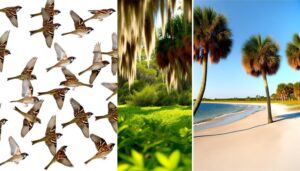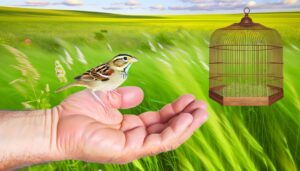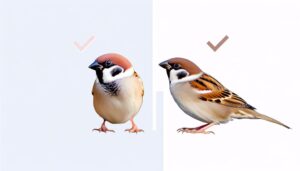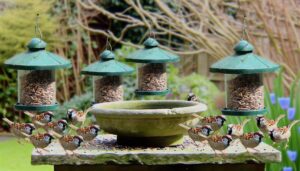Identifying Common Sparrows in Pennsylvania – A Birdwatcher’s Guide
Pennsylvania boasts a rich diversity of sparrows such as the Song Sparrow, known for its varied melodies, and the winter-visiting American Tree Sparrow, identified by its chestnut-colored cap. The Chipping Sparrow, with its vibrant vocals, and the Field Sparrow, a grassland dweller, are also prevalent in the state.
Every species contributes to the ecosystem through seed dispersion and pest control while providing food for predators. An exploration into unique song structures, feeding habits, and survival strategies of these small, stout birds reveals the resilience and complexity of Pennsylvania's sparrow population.
Digging deeper is certain to unfold more intriguing details.

Key Takeaways
- Pennsylvania is home to several sparrow species including Song Sparrows, American Tree Sparrows, Chipping Sparrows, Field Sparrows, and White-throated Sparrows.
- Sparrows in Pennsylvania play vital roles in the ecosystem, contributing to seed dispersion, insect control, and serving as a food source for local predators.
- Sparrows can be identified by their small size, stout body, short wings, and features like eye stripes, unique to individual species.
- Each sparrow species has a distinctive song and feeding habits, which are influenced by their habitat preferences and the seasons.
- Sparrow behavior in Pennsylvania includes ground feeding, social tendencies, non-migratory habits, and distinctive nesting practices using grass, twigs, and feathers.
Understanding Sparrow Species
In the midst of Pennsylvania's diverse avifauna, understanding sparrow species becomes an engaging yet complex endeavor, requiring a keen eye for detail and a solid grasp of their distinct characteristics.
Sparrows are small, plump, brown and grey birds with short tails and stubby, powerful beaks. They're often overlooked due to their ubiquity and monotone colors, but it's these very features that make them interesting. There's a subtle beauty in the sparrow's simplicity.
Consider the Chipping Sparrow, identifiable by its sleek, grayish chest, and the American Tree Sparrow, characterized by its rufous cap and eyeline. Each species has unique traits and behaviors that set it apart, and understanding these differences is key to appreciating the rich sparrow diversity in Pennsylvania.
Song Sparrow: The Musical Maestro
Pennsylvania's Song Sparrow is a true musical maestro, enchanting avian enthusiasts with its unique, intricate melodies.
This sparrow's habitat preferences and feeding patterns play a significant role in shaping these charming songs.
A thorough examination of these aspects will provide insight into the life and behaviors of this fascinating bird species.
Song Sparrow's Unique Melodies
One might be surprised to learn that the Song Sparrow, a common sight in Pennsylvania, is a veritable virtuoso, capable of producing a rich and varied repertoire of melodies.
Each individual sparrow has a unique sequence of notes, akin to a musician's personal composition. Remarkably, these melodies aren't innate but learned during a critical early-life period, from adult 'tutors.'
Song sparrows' tunes typically consist of a series of three to seven distinct phrases, often repeated. These phrases are interspersed with 'buzzes' or 'trills,' adding complexity to the song.
Ornithologists have noted that the song's structure might be influenced by factors such as habitat, social interactions, and age, a showcase of the Song Sparrow's adaptive musical capabilities.
Habitat and Feeding Patterns
Beyond their extraordinary musical abilities, Song Sparrows also display intriguing patterns in their habitat preferences and feeding strategies.
They're highly adaptable, inhabiting a variety of environments but showing a preference for edge habitats such as forest clearings and hedgerows.
Observations reveal Song Sparrows mainly forage on the ground for insects, seeds, and berries. They're also opportunistic, adjusting their diet based on season and availability.
During breeding season, they'll consume more insects and caterpillars, providing protein for their young. In winter, their diet shifts to seeds and fruits.
They've been observed employing a 'double-scratch' method, hopping forward and backward, to expose hidden food. Understanding these patterns provides insight into Song Sparrow's resilience in changing environments.
American Tree Sparrow: Winter Visitor
The American Tree Sparrow is a winter visitor to Pennsylvania. It can be identified by its grayish head and chestnut-colored cap.
This species displays unique winter habits. They often form large flocks to forage in weedy fields and shrubby areas.
Understanding these behaviors and characteristics can aid in their identification and conservation.
Identifying Tree Sparrows
Often seen in Pennsylvania during the colder months, the American Tree Sparrow is a small, hearty bird, easily identifiable by its rusty cap and eyeline, its light gray chest and belly, and the telltale dark spot at the center of its otherwise unmarked breast.
This bird's unique bi-colored bill, with a yellow lower mandible and a dark upper mandible, distinguishes it further. The wings display two thin, white wing bars, a subtle but essential detail for identification.
Juveniles closely resemble adults, but with streaked underparts, making identification a bit trickier. Observing the Tree Sparrow's size, approximately 5.5 to 6.3 inches in length, and listening for its sweet, high-pitched call can also assist in correctly identifying this winter visitor.
Sparrow's Winter Habits
In winter, you'll find the American Tree Sparrow adapting to Pennsylvania's colder climate by changing its feeding habits. It shifts from its typical diet of seeds and insects to a colder-weather menu of berries and grains. This adaptation allows the sparrow to efficiently extract energy from available food sources during the harsh winter months.
Observing these sparrows, you'll notice a behavioral change as well. They become more social and tend to form larger flocks, a survival strategy that offers protection and increased foraging success. Their plumage also changes, becoming denser to provide insulation against the cold.
Understanding these winter habits provides a fascinating insight into how the American Tree Sparrow, a common Pennsylvania visitor, adapts to survive and thrive in the challenging winter environment.
Chipping Sparrow: A Vibrant Vocalist
Pennsylvania's woodlands come alive with the ceaseless trills of the Chipping Sparrow, a petite songbird known for its striking vocal abilities. Scientifically known as Spizella passerina, its voice is a blend of high-pitched notes, creating a vibrant symphony in the wild.
Distinctively, it possesses a rusty cap and a black, thin bill, setting it apart from other sparrows.
Its song, a rapid, mechanical trill, echoes through the trees, signaling the bird's presence. This vocal prowess is primarily used for territorial claims and mate attraction.
Its diet includes seeds and insects, aiding in pest control. Nesting primarily in low trees or shrubs, it's a prevalent sight in Pennsylvania's woodland habitats.
Understanding the Chipping Sparrow's habits and traits provides a deeper appreciation for this tiny, vocal powerhouse.
Field Sparrow: The Open-Country Bird
Venturing out into the open country, you're likely to spot the Field Sparrow, scientifically known as Spizella pusilla, a bird that thrives in the grasslands and shrubby areas of Pennsylvania.
They're small, measuring around 5 inches in length, with a distinctive pink bill and a clear, unmarked breast. Their upperparts are brownish with a rusty cap, and their wings showcase white bars.
These birds are recognized by their unique song, a series of sweet, high-pitched notes that accelerate like a bouncing ball. They feed mainly on insects during summer and seeds in winter.
Field Sparrows' nests are built low in shrubs or grasses. They're an essential part of the ecosystem, controlling pest populations and aiding in seed dispersal.
White-throated Sparrow: The Striking Singers
Characterized by its striking white throat, the White-throated Sparrow stands out among Pennsylvania's common sparrows.
Its unique song, a melodious whistle that echoes through its preferred habitats of forests and thickets, is a key identifier for this species.
To fully appreciate this bird, one must also consider its particular feeding habits, which are closely tied to its environmental preferences.
Distinctive White-throated Appearance
Sporting a distinctive white throat patch, the White-throated Sparrow impresses birdwatchers with its striking features and melodious song.
This species, Zonotrichia albicollis, is adorned with a sharp, contrasting white bib bordered by black stripes, giving them a dashing look. Their brownish upper parts and grey underparts complete their striking appearance. Eye-catching yellow lores – the space between the eye and bill – add a dash of vibrant color.
They're typically medium-sized, about 6.75 inches long, with robust bodies and a round head. The males and females of the species express similar color patterns, but the intensity varies. It's this distinctive appearance that aids in their identification, making the White-throated Sparrow a unique member of Pennsylvania's avian community.
Understanding Their Unique Song
Echoing through Pennsylvania's forests, the sweet, lilting melody of the White-throated Sparrow's song offers a special signature sound that's as distinctive as their striking appearance.
This bird's song, often described as a plaintive whistle, typically consists of a series of pure-toned whistles followed by a trill. The pattern is usually phrased as 'Old Sam Peabody, Peabody, Peabody' or, in the North, 'Oh Sweet Canada, Canada, Canada'.
Their complex vocalizations are attributed to a high degree of learning, with young sparrows picking up their unique tunes from adult 'tutors'. Notably, the whistle's pitch and the trill's speed vary among individuals, likely contributing to mate attraction.
This captivating songbird's melody, filled with individualistic variation, is indeed a tribute to the beauty of nature's music.
Habitat and Feeding Habits
While the song of the White-throated Sparrow is certainly distinctive, it's their habitat and feeding habits that truly set them apart in Pennsylvania's diverse bird population.
Habitat: These birds thrive in the undergrowth of forests, often near clearings. They're particularly fond of scrubby, low-lying areas with an abundance of small trees and bushes.
Feeding Time: They're most active at dawn and dusk, hopping on the forest floor to forage for food.
Diet: Their diet primarily consists of seeds, berries, and insects. In winter, they'll also eat buds and twigs.
Feeding Method: They employ a unique feeding method, scratching the ground with both feet to uncover hidden food items.
This extraordinary lifestyle makes the White-throated Sparrow an intriguing part of Pennsylvania's avian ecosystem.
Sparrows and Pennsylvania's Ecosystem
In Pennsylvania's diverse ecosystem, sparrows play an indispensable role. They contribute to seed dispersion and insect control, serving as primary seed consumers that assist in the propagation of many plant species. Their diet, primarily composed of seeds and insects, helps maintain a balance in the ecosystem. Sparrows keep insect populations in check, providing a form of natural pest control beneficial to both agriculture and forest health.
They're also an important food source for local predators, linking several trophic levels in the food chain. Their nesting habits impact the environment, often choosing sites that influence the distribution of certain plant and animal species. Therefore, in Pennsylvania's ecological web, sparrows serve as critical players. Their activities provide a microcosm of nature's intricate balance.
Sparrow Identification: Key Features
Spotting a sparrow amidst the bustling birdlife of Pennsylvania requires keen observation and a sound knowledge of their distinguishing features.
Here are four key identifiers to aid your avian adventures:
- Size and Shape: Sparrows are small, typically between 5 to 6 inches long. They've a stout body, rounded head, and a short, stout beak.
- Color Pattern: Sparrows usually exhibit a brown or grey plumage. However, their belly is often lighter, and they may have streaks or patches of black, white, or other colors.
- Wings and Tail: Their short wings are rounded. The tail is either notched or squared.
- Eye Stripe: Many sparrow species also have a distinctive eye stripe.
Sparrow Behaviors and Habits
Having identified these common sparrows by their distinct physical features, let's now turn our attention to their unique behaviors and habits.
Sparrows are primarily granivorous, but they don't shy away from insects and fruit when available. They're social birds, often spotted in bustling flocks. Sparrows are ground feeders, hopping and scratching around for scattered seeds, their primary food source. Their nests, typically found in trees or shrubbery, are constructed from various materials like grass, twigs, and feathers.
They're known for their dawn chorus, a characteristic bird song performed in the early morning. Importantly, sparrows are non-migratory, meaning they remain in their native Pennsylvania throughout the year. Observing these behaviors yields insights into the life of these ubiquitous, yet fascinating birds.
Tips for Sparrow Watching
Often, the most successful sparrow watchers arm themselves with both patience and knowledge of these birds' distinct behaviors.
Here are four tips to enhance your sparrow watching experience:
- Silence and Stillness: Sparrows are often wary of sudden movements or loud noises. Maintaining quiet and calm can increase your chances of spotting these birds.
- Optimal Time: Sparrows are most active during early morning and late afternoon. So, these are the best times for observation.
- Proper Equipment: Binoculars are essential for detailed observation. A field guide can also be helpful for identifying different sparrow species.
- Location: Sparrows are typically found in open areas with low vegetation. Parks, gardens, and farmlands are ideal places to watch them.
Conservation Status of Sparrows
Despite their widespread presence, the conservation status of sparrows is a pressing concern, with several species facing population declines due to various environmental factors. Changes in farming practices, deforestation, and urbanization all contribute to habitat loss, which is the primary threat to sparrows in Pennsylvania.
Pesticides, too, play a significant role, as they not only poison the birds directly but also deplete their food supply. The Grasshopper Sparrow, for instance, is listed as a 'Species of Special Concern' in the state due to a dramatic reduction in its population. Similarly, the Eastern Towhee has seen a 49% decline over the past 30 years.
It's clear that, despite their seeming ubiquity, sparrows urgently need our attention and conservation efforts.
Encouraging Sparrows in Your Backyard
To counteract these challenges and support the survival of these birds, there are simple steps one can take to make backyards more inviting for sparrows.
- Provide Food: Sparrows are primarily seed eaters. Offering a variety of seeds, such as sunflower and millet, in bird feeders can attract them.
- Ensure Water Availability: A birdbath or a shallow container of water serves the dual purpose of hydration and bathing.
- Create Nesting Sites: Sparrows prefer nesting in dense shrubs or man-made structures. Installing nesting boxes at suitable heights can encourage their presence.
- Pesticide-Free Environment: Avoid using pesticides in your yard. They can harm the sparrows' food sources, indirectly affecting their health and survival.
These measures, if implemented, can significantly enhance the sparrow population in your backyard.
Conclusion
In a world increasingly urbanized, the humble sparrows of Pennsylvania – from the melodic Song Sparrow to the vibrant Chipping Sparrow – add a touch of nature's charm to our lives.
Consider the delight of a child spotting an American Tree Sparrow on a frosty winter morning, a joyous indication of the resilience of these little creatures.
Let's foster their survival, encouraging their presence in our backyards, and pass on the joy and wonder of birdwatching to future generations.






